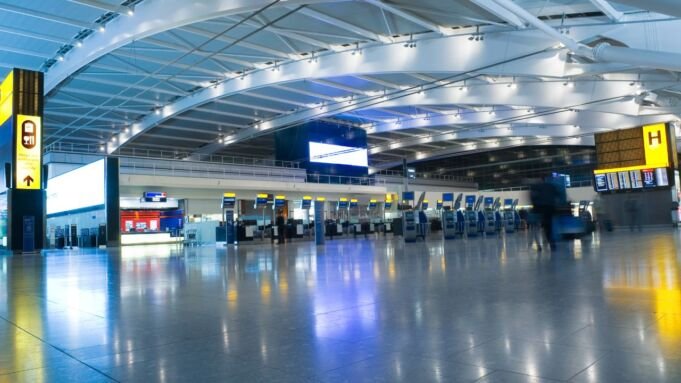Bogota’s El Dorado International Airport stands as a testament to modernity and scale, nestled in the city’s western expanses. It proudly holds the position as Latin America’s third-largest airport, trailing only behind those in Mexico City and Sao Paulo, with a bustling throughput of approximately 30 million passengers annually.
As we ventured into 2019, the airport boasted a diverse array of 42 airlines. This mix included 21 international carriers, a dedicated group of 6 for domestic routes, and 15 specialized in cargo transportation, showcasing El Dorado’s pivotal role in both global and local air travel networks.
El Dorado isn’t just remarkable for its size; it’s equally renowned for its quality. For three consecutive years, it has been honored as the Best Airport in South America. Furthermore, its global standing is nothing short of impressive, with Skytrax—a leading authority in airport rankings—placing it 46th worldwide. This accolade is a testament to El Dorado’s commitment to providing exceptional service and a seamless travel experience to passengers from across the globe.
History of The Bogota Airport
El Dorado International Airport, Bogotá’s primary aviation gateway, has a rich history dating back to its inauguration in 1959. Named after the legendary golden city sought by explorers, it was built to accommodate the growing demand for air travel in Colombia and to replace the older Techo Airport.
Over the decades, El Dorado has undergone significant expansions and modernizations to transform into one of Latin America’s busiest airports. It now serves as a crucial hub for both domestic and international flights, connecting millions of passengers each year to destinations across the globe.
The airport’s evolution reflects Bogotá’s rise as a key economic and cultural center, symbolizing Colombia’s aspirations and its pivotal role in regional and global air transportation.
What is Bogota Airport?

El Dorado International Airport in Bogota is poised for a significant expansion, with the potential to nearly double its capacity by 2037, catering to Colombia’s booming tourism sector. A recent study by the International Air Transport Association (IATA) reveals that the airport, currently Latin America’s second busiest, could see passenger numbers soar from 35.3 million in 2022 to 68.2 million.
To accommodate this surge, IATA recommends 23 strategies, including extending Palanquero airspace operations to 24/7, promising substantial fuel and CO2 savings. Paula Bernal, IATA’s General Manager in Colombia, emphasized El Dorado’s critical role in enhancing the efficiency of the nation’s airport network, underscoring its importance in facilitating both domestic and international connections.
How Does Bogota Airport Operate?
El Dorado International Airport in Bogotá, Colombia, operates as a major hub for both domestic and international flights, serving as a key gateway to South America. Understanding how the airport works can help travelers navigate it more efficiently. Here’s an overview of its operation:
Terminals
- Two Main Terminals: El Dorado has two main terminals – Terminal 1 (T1) and Terminal 2 (T2). T1 handles both international and domestic flights, while T2, also known as Puente Aéreo, primarily serves domestic flights, especially those operated by Avianca.
- Inter-Terminal Transportation: A free shuttle bus connects the two terminals, facilitating easy transfers for passengers.
Check-In and Security
- Check-In: Passengers can check in at their respective airline counters in the terminal their flight departs from. Self-service kiosks and online check-in options are also available for convenience.
- Security Screening: After check-in, passengers go through security screening. It’s advisable to arrive at the airport at least 3 hours before international departures and 2 hours before domestic flights to allow sufficient time for this process.
Customs and Immigration
- International Arrivals: Passengers arriving on international flights will go through immigration control where they’ll present their travel documents and may be asked about their visit. Following immigration, baggage is collected, and customs checks are conducted.
- Departing International Flights: For international departures, passengers may need to complete exit immigration procedures.
Facilities and Services
- Wide Range of Amenities: El Dorado offers numerous facilities, including duty-free shopping, dining options ranging from fast food to sit-down restaurants, free Wi-Fi, currency exchange bureaus, and VIP lounges.
- Transportation Services: Various transportation options are available, including taxis, ride-sharing services, and public buses, to get to and from the airport.
Connecting Flights
- Transfer Desks: For passengers with connecting flights, transfer desks are available to facilitate check-in for the next leg of their journey without needing to exit and re-enter the security area.
- Baggage Handling: If your baggage isn’t checked through to your final destination, you’ll need to collect and re-check it at El Dorado.
Accessibility and Assistance
- Services for All: The airport provides services for passengers with reduced mobility or other needs, including wheelchair assistance and priority services throughout the airport.
Safety and Health Protocols
- Adherence to Regulations: El Dorado follows international safety and health protocols, including enhanced cleaning procedures, social distancing measures, and requirements for wearing masks.
Understanding these aspects of El Dorado International Airport’s operation can significantly streamline your travel experience, whether you’re beginning your journey in Bogotá, transferring to another flight, or exploring the city during a layover.
Bogota Airport Features and Specifications

El Dorado International Airport, located in Bogotá, Colombia, is one of the most important aviation hubs in Latin America. Its features and specifications highlight its capacity to handle a high volume of passengers and cargo, making it a key player in the region’s air transport infrastructure.
Here are some of the standout features and specifications of Bogotá’s El Dorado International Airport:
Terminal Layout
- Terminals: The airport has two main terminals – Terminal 1 (T1) for international and domestic flights and Terminal 2 (T2), also known as Puente Aéreo, mainly for domestic flights.
- Modern Facilities: Both terminals offer a range of passenger services including dining, shopping, lounges, and currency exchange.
Capacity and Operations
- Passenger Volume: El Dorado is designed to handle over 30 million passengers annually, with the capacity expanding through ongoing development projects.
- Cargo Hub: It is the largest cargo airport in Latin America, reflecting its significant role in regional and international trade.
Runways and Airspace
- Runways: The airport features multiple runways that can accommodate the largest commercial aircraft, including the Airbus A380 and Boeing 747.
- Advanced Navigation: Equipped with the latest in air traffic control technology, El Dorado ensures safe and efficient operations, even in Bogotá’s often challenging weather conditions.
Accessibility and Connectivity
- Location: Approximately 15 kilometers west of downtown Bogotá, it offers various transportation options, including taxis, buses, and ride-sharing services.
- Connectivity: Serves as a major hub for flights within Colombia, as well as international connections to the Americas, Europe, and beyond.
Sustainability and Technology
- Eco-friendly Initiatives: Efforts to reduce carbon emissions and enhance environmental sustainability are in place, including the use of energy-efficient technologies.
- Technological Advancements: Offers free Wi-Fi, mobile charging stations, and digital information screens to enhance the passenger experience.
Safety and Security
- Security Measures: Comprehensive security checks and modern surveillance systems are deployed throughout the airport to ensure passenger safety.
- Health Protocols: Adaptability to global health standards, including measures for pandemic response, like social distancing markers and increased sanitation.
Awards and Recognition
- International Accolades: Consistently ranked among the best airports in South America for its facilities, services, and customer satisfaction.
El Dorado International Airport is more than just a transit point; it’s a gateway to Colombia’s rich culture and beautiful landscapes, equipped to provide a comfortable and efficient travel experience for millions of visitors each year.
Top Locations Bogota Airport
Exploring the area around El Dorado International Airport in Bogotá, Colombia, offers visitors a variety of attractions and top locations worth visiting, whether you’re on a layover or starting your Colombian adventure.
Here are some of the top locations and attractions near Bogotá’s airport:
La Candelaria
- Distance from Airport: Approximately 15km east of the airport.
- Description: Bogotá’s historical and cultural heart, La Candelaria is renowned for its colonial architecture, museums, and vibrant street art. Don’t miss the Gold Museum (Museo del Oro) and Botero Museum.
Monserrate
- Distance from the Airport: Around 17km east.
- Description: Offering panoramic views of the city, Monserrate is a mountain that towers over Bogotá. Visitors can reach the summit via cable car, funicular, or by hiking, to visit the church and enjoy the spectacular cityscape.
Simón Bolívar Metropolitan Park
- Distance from the Airport: About 10km south.
- Description: This is Bogotá’s largest park and a perfect place for relaxation and outdoor activities. It includes lakes, sports facilities, and concert venues, making it a popular spot among locals and tourists.
Botanical Garden of Bogotá (Jardín Botánico de Bogotá)
- Distance from the Airport: Roughly 8km south.
- Description: Featuring a vast collection of Colombian flora, the Botanical Garden is a peaceful retreat from the city’s hustle. It’s an ideal spot for nature lovers and those interested in learning about the country’s diverse plant life.
Maloka Interactive Center
- Distance from the Airport: Approximately 10km southeast.
- Description: An interactive science and technology museum that offers engaging exhibits and activities for visitors of all ages. It’s a great place to learn about scientific principles in a fun and interactive way.
Salitre Mágico
- Distance from the Airport: About 10km south.
- Description: One of Bogotá’s largest amusement parks, offering a variety of rides and attractions for families and thrill-seekers alike.
Gran Estación Shopping Mall
- Distance from the Airport: Roughly 10km south.
- Description: A major shopping center in Bogotá, featuring a wide range of stores, dining options, and entertainment facilities, including cinemas and a bowling alley.
Plaza de Mercado de Paloquemao
- Distance from the Airport: Around 12km southeast.
- Description: Experience the local flavor at one of Bogotá’s largest and most vibrant markets. Here, you can find fresh produce, flowers, meats, and traditional Colombian food.
These locations offer a glimpse into the diverse attractions Bogotá has to offer, ranging from cultural and historical sites to natural beauty and modern entertainment. Whether you’re looking to explore Colombian history, enjoy the outdoors, or simply relax and have fun, the area around El Dorado International Airport has something for everyone.
Where to Stay in Bogota?

Choosing where to stay in Bogotá largely depends on your interests, whether you’re in the city for tourism, business, or a blend of both. Each neighborhood offers a unique vibe and attractions. Here are some of the best areas to consider for your stay:
1. La Candelaria
- Ideal for: Tourists and history enthusiasts.
- Why Stay Here: As the historical heart of the city, La Candelaria is brimming with colonial architecture, museums, and cultural sites. It’s perfect for those looking to immerse themselves in Bogotá’s rich history and vibrant arts scene.
2. Chapinero
- Ideal for: Young travelers and nightlife seekers.
- Why Stay Here: Known for its diverse community, trendy cafes, and bustling nightlife, Chapinero offers a lively urban experience. It’s also home to the Zona G, famous for its gourmet dining options.
3. Zona T and Zona Rosa
- Ideal for: Shoppers and those seeking entertainment.
- Why Stay Here: These adjacent zones are the go-to places for high-end shopping, dining, and nightlife. With a wide selection of bars, clubs, and international restaurants, it’s a hub of activity both day and night.
4. Parque 93
- Ideal for: Families and business travelers.
- Why Stay Here: This upscale area is known for its tranquil park, surrounded by restaurants and cafes. It’s a bit more laid-back than Zona T but still offers plenty of dining and entertainment options, with the added benefit of being family-friendly.
5. Usaquen
- Ideal for: Those looking for a local experience.
- Why Stay Here: Once a separate town, Usaquén has been enveloped by the city but retains a distinct charm with its flea market, local eateries, and artisan shops. It’s a great place to enjoy a more relaxed pace while still having access to the city’s amenities.
6. Corferias
- Ideal for: Business travelers and expo visitors.
- Why Stay Here: Located near the international exhibition and convention center, Corferias is convenient for those attending events there. The area offers a range of accommodations, from budget hotels to luxury stays.
7. Teusaquillo
- Ideal for: Those interested in architecture and a quiet retreat.
- Why Stay Here: Known for its beautiful early 20th-century English-style houses, Teusaquillo offers a peaceful stay with easy access to the city’s main attractions and the Simón Bolívar Park.
When choosing your accommodation, consider proximity to the attractions or activities you’re most interested in, as well as the type of neighborhood vibe that suits your travel style. Bogotá offers a wide range of lodging options, from luxury hotels and boutique guesthouses to hostels and Airbnb rentals, ensuring something for every traveler’s taste and budget.
What People Say About Bogota Airport?
Travelers often praise El Dorado International Airport for its modern facilities, cleanliness, and efficient services. Many commend the airport’s spacious and well-organized terminals, highlighting the wide variety of dining and shopping options available.
The free Wi-Fi and numerous charging stations are frequently mentioned as convenient for passengers waiting for their flights. While some travelers note the airport can be busy, leading to longer wait times during peak hours, the overall sentiment is positive, particularly regarding the helpfulness of the staff and the cleanliness of the restrooms.
The airport’s commitment to maintaining high standards of passenger experience places it favorably in the eyes of both domestic and international visitors.
Tips for Bogota Airport
El Dorado International Airport (BOG) serves as the main gateway to Colombia and is a vital hub for travelers exploring the vibrant capital city of Bogotá and beyond. To ensure a smooth and stress-free experience, here are some essential travel tips for navigating this bustling airport:
1. Arrive Early
For international flights, aim to arrive at least 3 hours before departure. For domestic flights, 2 hours should suffice. This allows ample time for check-in, security checks, and any unforeseen delays.
2. Transportation to and from the Airport
Taxis, app-based ride services, and public buses are readily available. For a hassle-free journey, consider booking an official airport taxi from the designated counters inside the terminal or using reputable ride-sharing apps for a direct trip to your destination.
3. Stay Connected
El Dorado offers free Wi-Fi throughout the terminals. Keep your device handy to stay updated on flight statuses, and gate changes, and to access digital maps of the airport.
4. Money Matters
Currency exchange services and ATMs are available in both terminals. It’s advisable to withdraw or exchange a small amount of Colombian Pesos (COP) for immediate expenses like transportation or snacks.
5. Navigating the Terminals
El Dorado consists of two main terminals: T1 for international and domestic flights, and T2 primarily for domestic flights. A free shuttle bus connects both terminals, running every 20 minutes from 5:00 AM to 11:00 PM.
6. Security and Customs
International travelers should be prepared for customs and immigration checks. Keep your travel documents, including your passport and any required visas, easily accessible.
7. Dining and Shopping
Explore a variety of dining options, from quick snacks to sit-down meals, reflecting both local and international cuisines. The airport also offers a range of shopping outlets, perfect for last-minute gifts or travel essentials.
8. Lounge Access
For a more relaxed wait, several airline lounges and paid-entry lounges offer comfortable seating, refreshments, and showers. Check your eligibility based on your ticket class or loyalty program memberships.
9. Health and Safety Measures
Stay informed about current health and safety protocols at the airport, including mask mandates and social distancing guidelines. Hand sanitizer stations are widely available throughout the terminals.
10. Explore with Time
If you have a long layover, consider exploring Bogotá’s cultural landmarks, such as the historic center (La Candelaria), the Gold Museum, or Monserrate Hill. Just ensure you have enough time to return for your flight and be mindful of traffic conditions.
By following these tips, you’ll navigate El Dorado International Airport with ease, setting the stage for a memorable visit to Bogotá and Colombia. Safe travels!
Conclusion
El Dorado International Airport stands as a testament to Bogotá’s growth and its strategic importance in Latin America’s aviation landscape. With state-of-the-art facilities, a wide array of services, and a commitment to passenger satisfaction, it effectively bridges Colombia with the world.
Serving as a crucial hub for millions of travelers, El Dorado facilitates not only the exploration of Colombia’s rich cultural heritage but also supports the nation’s economic development and connectivity. As it continues to expand and modernize, El Dorado International Airport ensures a seamless and welcoming gateway to all who pass through its doors.
Frequently Asked Questions (FAQs)
What terminals does El Dorado International Airport have?
El Dorado International Airport features two main terminals: Terminal 1 (T1) for international and some domestic flights, and Terminal 2 (T2), also known as Puente Aéreo, primarily for domestic flights.
How do I transfer between Terminal 1 and Terminal 2?
A free shuttle bus service facilitates transfers between T1 and T2. The shuttle operates every 20 minutes from 5:00 AM to 11:00 PM.
Are there any facilities for passengers with a long layover?
Yes, the airport offers various lounges, dining options, and free Wi-Fi to keep passengers comfortable. For longer layovers, some hotels are located near the airport.
Can I leave the airport during a layover in Bogotá?
Yes, passengers can leave the airport during a layover, but it’s important to consider visa requirements and ensure you have enough time to return for your connecting flight.
Is there free Wi-Fi available at the airport?
Yes, El Dorado International Airport offers free Wi-Fi access throughout its terminals.
Where can I find luggage storage services at the airport?
Luggage storage services are available in both Terminal 1 and Terminal 2. Look for the “Left Luggage” signs or ask at an information desk.
What are the currency exchange facilities at the airport?
Currency exchange bureaus are located in both terminals, offering competitive rates for a variety of currencies.
Can I find facilities for disabled passengers at the airport?
El Dorado International Airport is equipped with facilities for disabled passengers, including wheelchair access and dedicated assistance services.
How early should I arrive at the airport before my flight?
For international flights, it’s recommended to arrive at least 3 hours before departure. For domestic flights, arriving 2 hours in advance is advisable.















